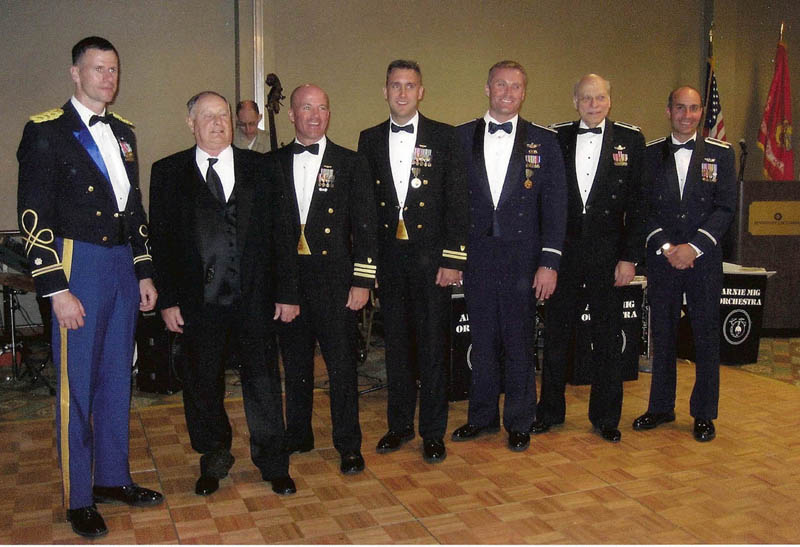|
|
| The
Aviator Valor Awards for 2007
|
| |

|
2007 Aviators Post Valor Awards Military Ball
L to R: Lt. Col. Allan
Pepin, US Army (Presenter); Mr. David Cooper, Father
of CW5 David Cooper (Recipient, unable to attend); CDR Thomas
Maine, USCG (Presenter); Lt. Matthew Furlong, USCG (Recipient);
Maj. Jack Aalborg, USAF (Recipient), Col. Gabe Sunshine, Post
Commander; Maj. Michael Baltzer, USAF, Post Coordinator
| CW5
David Cooper, U.S. Army |
|
CW5
David Cooper distinguished himself through conspicuous
gallantry in action while serving as an AH-6 Flight Lead
Pilot, operating against an enemy force northeast of
Baghdad, Iraq. On 27 November 2006, CW5 Cooper launched
his AH-6 as part of a daytime Helicopter Assault Force
(HAF) in order to kill or capture an Iraqi-based foreign
fighter facilitator. During the flight, CW5 Cooper's
AH-6 wingman sustained significant damage by enemy
fire and crash landed. 'The remainder of the HAF landed
in a defensive perimeter around the badly damaged aircraft.
Although both pilots were without significant injury,
the aircraft could no longer be flown and the Air Mission
Commander made the decision to secure the site and
await a Downed Aircraft Recovery Team (DART).
Approximately
40 minutes after landing, several enemy trucks with
heavy weapons moved into position and began engaging
the ground force and aircraft with anti-aircraft machine
guns, rocket propelled grenades and small arms fire.
The entire ground force was out-gunned and out-numbered.
Without hesitation and while receiving direct enemy
fire, CW5 Cooper and his co-pilot moved to their aircraft
and took off to provide much-needed suppression on the
enemy forces. Coming under intense enemy fire, CW5 Cooper
began to engage the enemy. He made multiple passes, initially
destroying several gun trucks and killing at least
ten enemy personnel. At this point, all enemy weapon
systems and personnel were clearly aiming at him, yet
he continued to fly multiple gun runs straight into
the heavy machine gun fire of the enemy and placed devastating
fires upon them.
Out of ammunition
and low on fuel, CW5 Cooper landed back at
the ground force location and immediately began re-arming
his helicopter with rockets and ammunition, and transferring
fuel, from his wingman's downed aircraft. He
then took off again and began to engage enemy vehicles
and personnel. As he continued with his engagements,
he repeatedly found that some of the rockets removed
from the downed AH-6 malfunctioned and did not launch.
Very much aware of the possibility that unstable rockets
could detonate in his launcher, he continued to engage
the enemy and destroyed several more gun trucks and killed
nearly ten more personnel.
As a result
of CW5 Cooper's devastating fire and aggressive
actions, the enemy completely broke contact and began
to flee the area. His performance of duty assured
the survival of this embattled element and is in keeping
with the finest traditions of the special operations
community. His actions displayed the highest levels
of valor and gallantry in combat and reflect great
credit upon himself, this Command, and the United States
Army.
|
Lt. Matthew Furlong,
U.S. Coast Guard |
|
Lieutenant Matthew
S. Furlong is cited for meritorious achievement in aerial
flight while serving as Aircraft Commander aboard HH-60J
helicopter 6034 on the night of 27 May 2006. After enduring
three days of extreme weather, the 39-foot sailing vessel
Caledonia II was left damaged and adrift in 20-foot seas,
295 nautical miles southeast of Cape Cod. Responding to
their distress call, Lieutenant Furlong and his crew launched
and flew through darkness in instrument meteorological conditions,
fighting severe headwinds and dangerous lines of thunderstorms.
The Caledonia II was at the extreme range limit of the
HH-60J helicopter, testing every bit of Lieutenant Furlong's
airmanship and skills in all phases of the harrowing mission.
He expertly oversaw the critical
fuel calculations and masterfully orchestrated the ideal
plan for the rescue of the five helpless sailors. His exceptional
situational awareness ensured that a maximum range profile
was maintained and, once on scene, he skillfully maneuvered
the helicopter into a perfect hover position and began
hoisting, despite the ferocious waves and lack of visual
references. Lieutenant Furlong demonstrated keen situational
awareness by skillfully managing CG 6034's on-scene time
and upon reaching the predetermined bingo fuel state, made
the critical decision to remain on scene for the additional
time required to complete the last two hoists. Battling
all of the elements, including the wildly swinging mast
of the stricken vessel, he flawlessly maintained a steady
hover, maneuvering as necessary to hoist each survivor.
Once the fifth survivor was safely inside the cabin,
Lieutenant
Furlong turned his attention to ensuring a safe transit
to the closest point of land, recovering at Air Station
Atlantic City with minimum fuel and ending the exhausting
six-hour rescue mission with the sailors safely ashore.
His superb airmanship, judgment, and decision-making
saved the lives of five sailors nearly 300 miles offshore.
Lieutenant Furlong's courage, judgment, and devotion to
duty are most heartily commended and are in keeping with
the highest traditions of the United States Coast Guard.
|
Major
Jack Aalborg,
U.S. Air Force |
|
Major John T. Aalborg
distinguished himself in aerial combat over Afghanistan
through aviation leadership excellence as Assistant Operations
Officer and MC-130H Instructor Pilot, 7th Special Operations
Squadron, Royal Air Force Mildenhall, United Kingdom. On
10 September 2006, while deployed in support of Operation
ENDURING FREEDOM, Major Aalborg launched his MC-130H Combat
Talon II from alert to flawlessly execute an emergency
re-supply airdrop to a special operations ground team critically
low on ammunition and engaged in a firefight with Taliban
forces.
In spite of two aircraft-grounding
conditions, Major Aalborg led his crew and aircraft to
a takeoff within forty-three minutes from notification.
The crew's spot-on visual drop procedures delivered the
ammunition to within twenty feet of the team's safe house
door. The distinctive accomplishments of Major Aalborg
reflect great credit upon himself and the United States
Air Force. |
X
Close Window
|
|
|
 |
|
|